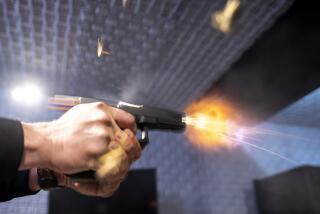Teens inhaling blow-gun darts
Don’t run with scissors, and don’t inhale homemade blow-gun darts.
Pediatric surgeons issued a warning about accidental inhalation of homemade blow-gun darts, after treating three teenage boys in three months at Nationwide Children’s Hospital in Columbus, Ohio.
All three required bronchoscopic procedures under general anaesthesia to remove the darts, which can be an inch or more in length, according to Dr. Kris R. Jatana, a pediatric surgeon and otolaryngologist at the hospital, a teaching facility of Ohio State University.
“We know that there are other cases that haven’t been widely reported in the literature,” said Jatana, lead author of the warning published online Monday in the journal Pediatrics. Several colleagues had come across similar cases at other facilities where they worked, Jatana said.
Two of the boys, ages 14 and 15, were reluctant to admit they had inhaled the darts, discovered in X-rays after they reported breathing difficulties.
Several YouTube videos, some from self-described survivalists, describe how to make the darts from such items as wire and needles inserted in a frayed shoelace tip or pencil eraser. Few offer any precautions about launching them. The blow guns are simple tubes, generally fashioned from pieces of PVC pipe, metal conduit or curtain rods.
On one such website, TheSurvivalistBlog.net, a writer who identified himself as a sixth-grader showed how to fashion a large dart from a nail and sheet of paper. For his efforts, he got a free copy of a survivalist guide, according to the blog.
The victims all made the same mistake: taking a deep breath while the blow gun was pressed against their lips, said Jatana.
“When the child maximally inhales, the vocal cords are open and the foreign body can go straight into the airway without obstruction,” Jatana said.
The three cases in Ohio were not complicated by further injury, but Jatana warned that the darts can puncture large blood vessels and cause serious bleeding. “These three children were very fortunate to have good outcomes,” he said.
Blow-gun darts are not the most common sharp foreign object removed after trips to emergency rooms – pushpins, sewing needles and hatpins greatly outnumber the darts. One report from British Columbia Children’s Hospital chroncled seven patients, ages 11 to 15, treated from 1998 to 2006. One inhaled a blow gun dart. The remaining inhaled tacks or needles.
Several published reports in medical journals have warned about inhalation of scarf pins among Islamic girls.
“Certainly other foreign bodies have been more prevalent in the teenage populations,” said Jatana, who has removed pushpins and needles as well.
Jatana said it isn’t possible to estimate how many cases may have been occurring, but the unusual number in a short time spurred him and four colleagues at the hospital to describe the cases and compose a warning to other physicians, parents and the teens themselves.
“It’s just one of those things that could be an emerging problem,” Jatana said. “We’re really obligated to let people know that this occurred.”







